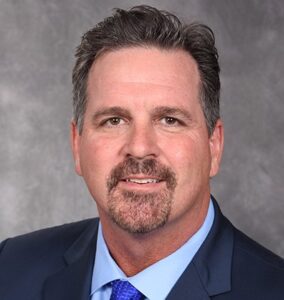Since the height of the pandemic, education technology has proven itself instrumental to the academic success of K12 students. Schools continue to rely on its use to help students bounce back from pandemic-related learning loss, career development and even virtual field trips. And for these five leaders, edtech has been crucial for their district’s and school’s success.
For many districts, the pandemic came as a wake-up call urging leaders to get up to speed in the edtech sense. According to David Hoffert, superintendent of Warsaw Community Schools, his community was ready.

“WCS has been a leader in instructional technology and was an early adapter to 1:1 technology,” he says. “When the pandemic hit, we were prepared with devices and basic instructional practices.”
What did come as a shock was the depth needed to adapt to the pandemic.
“The lessons learned pushed us out of our comfort zone and helped us create a model for post-pandemic instructional practices,” he explains. “Our movement—and continual push—is to create a synchronous learning environment when using technology. Students crave personal interaction and not a pre-recorded lesson. Collaborative tools for new forms of communication with students, parents and the community have become a must!”
This frame of mind is also shared by Josh Carter, principal of Science Hill High School of Johnson City Schools in Tennessee, who took measures to ensure his school was utilizing technology before COVID-19.
“Prior to the pandemic, we had already made several important moves toward integration of educational technology,” he says. “We had been one-to-one for a couple of years. Our students have Chromebooks and our teachers were using Canvas and several other ed tools.”
However, he notes that the pandemic elevated the school’s use of these tools. It allowed all of his teachers to become fully immersed in Canvas, and now edtech is here to stay.

“That immersion has continued, and all of our classes have a robust presence on Canvas,” he says. “As far as other tech tools, our staff is much more likely to try new things post-pandemic. Most of our classrooms use technology to enhance their lessons on a daily basis.”
As K12 school districts continue to embrace innovative edtech tools, District Administration sought to understand which solutions have proven most successful for some of the most impactful leaders in education. And to no surprise, Canvas, VR simulations and Google products seem to dominate the education sphere.
Lenon Harvey, director of information services at Putnam County School District, which is led by Florida’s 2023 Superintendent of the Year Richard Surrency, says tools like GoGuardian, Clever, Canvas, GoogleWorkspace, Renaissance Learning Products, Savvas and McGraw Hill are among the tools that have had “a significant impact” on his district’s students and staff. What sets these platforms apart, he notes, is their efficiency, personalized learning experiences, collaboration and access to digital resources.

“We had a deliberate process for incorporating new edtech tools into our teaching and learning practices that ensures they are effective and safe for our students,” Harvey says. “Our IT department has recently developed a Technology and Infrastructure for Digital Education (TIDE) plan, which includes Innovation Navigators responsible for vetting the efficacy of new programs before they are implemented in our district. This ensures that all tools we adopt are thoroughly evaluated and meet our high standards for effectiveness, data privacy and security.”
He adds that they also utilize coaches within their “Teaching and Learning Department,” who evaluate the efficacy of curriculum programs before they’re adopted to ensure all aspects of teaching and learning are impactful.
Similarly, Carter says tools like Nearpod, IXL and Hapara are widely used by his teachers, which he says have profoundly impacted how teachers deliver content, student engagement and closing learning gaps.
To be a school that leverages edtech to enhance learning engagement, he says they must be innovative yet cautious to ensure their interventions are effective.
“Six years ago, our district started a Teacher Leader program for educational technology,” Carter says. “Each cohort participates in a year-long program that trains them to be technology leaders in their building. When a teacher at Science Hill wants to learn about a new tool, the teacher leaders are here to help. They provide professional development sessions as well as one-on-one assistance. These teacher leaders, along with our district supervisor of educational technology, vet potential ed tools regularly.”
More from DA: This principal and a superintendent made historic gains this year. What’s next?

Don Killingbeck, superintendent at Hemlock Public Schools in Michigan, has long known the importance of technology in the classroom, which proved instrumental in their transition to remote and blending learning during the pandemic.
Since then, his district has added several platforms to its “edtech toolbelt,” such as Google Classroom, Paper, NWEA, Skyward, Kami, GoGuardian, Edgenuity, IXL and SAM Labs.
“Overall, these tools can be impactful for students and staff by providing greater access to resources, promoting personalized learning and improving communication and collaboration between teachers and students,” Killingbeck says.
“For the most part, we believe that technology tools should serve the purposes of either improving instruction or simplifying processes to make either or both the student and staff experience better,” he adds. “We believe that the best ideas come from staff in the field and try to harvest their ideas and implement them in a variety of ways.”
Fidelity, intuitiveness and ease of access for students, teachers and parents are some of the primary necessities of a successful edtech tool, WCS Superintendent Hoffert says. His district’s post-pandemic response is to focus on what works and what doesn’t.
“Too much of everything is nothing and unrealistic to support appropriately,” he says.
Tools like Google Classroom, Google Suite, SeeSaw, Canvas, Apptegy and ParentSquare have become some of the district’s most valuable solutions.
“Google has become a ‘go to’ in many facets of life and there is a comfort with parents along with ease of integration,” he notes. In addition, they’ve been intentional when it comes to relying on data and feedback to make such decisions.
“As a district of roughly 7000 students and 500 certified teachers, it is important that our technology department can support the devices and programs,” he says. “Through the feedback and continual evaluation, our teams are able to provide implementation and ongoing support of the recognized technological devices and district-approved programs.”

Alongside the explosion of education technology exists a need to support students as they prepare for a career after graduation. Jonathan
Prince, superintendent of St. Lucie Public Schools in Florida, said the goal is to mix the two ideas using virtual reality.
SLPS leverages a variety of simulations ranging from driver’s ed to welding. By using VR, students can gain real-world experience without the fear of seriously injuring themselves or others.
“These are very inexpensive tools to teach kids, particularly in career and technical education, how to use a welder and how to weld materials,” Prince says. “We have a lot of internships in our district with local industries, but the bottom line is a lot of times before those internships start, the kids are ready to go because of the technology they’re afforded in the classroom with some of these simulations.”
Edtech in 2023-24
As this school year soon comes to a close, district leaders have already begun preparations for 2023-24. If schools learned anything from the pandemic, it’s that we shouldn’t return to normal. And according to these leaders, they don’t intend to.
“It’s true that the edtech industry will continue to evolve and change in the coming years, and there will likely be winners and losers,” says Killingbeck. “The pandemic has accelerated the adoption of technology in education, and many schools and districts have had to quickly implement new solutions to support remote and hybrid learning. As we move forward, it will be important for districts and solution providers to continue to focus on providing effective and impactful solutions that meet the needs of students and teachers. This may require innovation, collaboration and a willingness to adapt to changing circumstances. Ultimately, the success of edtech solutions will depend on their ability to support student learning and achievement.”









